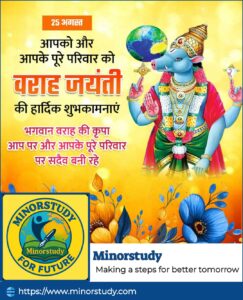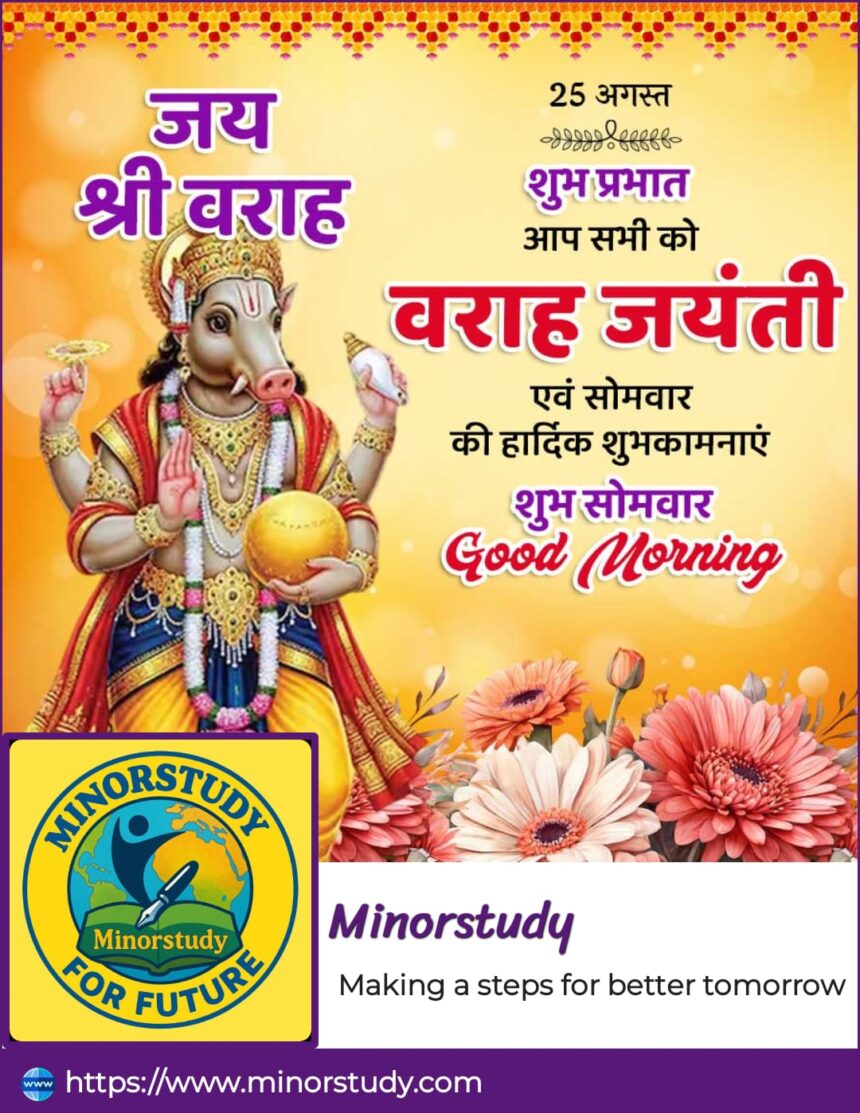Varaha Jayanti – History, Timeline, Facts, Significance, and Daily Life Inspiration
Introduction
India is a land of festivals, each with deep spiritual, cultural, and social meanings. Among the many sacred Hindu observances, Varaha Jayanti stands as a powerful reminder of divine protection and cosmic balance.
Varaha Jayanti commemorates the incarnation (avatar) of Lord Vishnu as Varaha, the divine boar, who saved Mother Earth (Bhudevi) from drowning in the cosmic ocean. It is a day to honor the third avatar of Vishnu, who symbolizes strength, courage, and restoration of dharma.
This festival is not just about worship; it is about understanding the eternal truth that whenever darkness prevails, divine power restores light and balance. In this article, we will explore the history, timeline, facts, significance, observance, wishes, and daily life impacts of Varaha Jayanti in a simple, human-friendly way.
History of Varaha Jayanti
The story of Varaha Avatar is narrated in ancient scriptures such as the Vishnu Purana, Srimad Bhagavatam, and Padma Purana. According to the legend:
The Demon Hiranyaksha: A mighty demon (asura), Hiranyaksha, performed severe penance and was granted immense strength by Lord Brahma. With his arrogance, he troubled gods, humans, and sages.
Earth in Danger: Hiranyaksha carried Mother Earth (Prithvi Devi) and submerged her deep into the cosmic ocean, causing imbalance in creation.
The Divine Incarnation: To restore balance, Lord Vishnu took the form of a giant boar (Varaha).
Battle and Victory: Varaha fought a fierce battle with Hiranyaksha that lasted for a thousand years. Finally, he defeated the demon.
Restoration of Earth: Lord Varaha gently lifted the Earth on his tusks and placed her back in the universe, ensuring the continuity of life.
Thus, Varaha Jayanti marks the victory of good over evil and the restoration of order in the cosmos.

Timeline of Varaha Jayanti
Vedic Era – Early mentions of divine incarnations appear in scriptures.
Puranic Times – The full story of Varaha Avatar was narrated in Bhagavatam and Vishnu Purana.
Medieval Period – Temples dedicated to Varaha Avatar were built, especially in South India.
Modern Era – Varaha Jayanti continues to be observed by millions of devotees with devotion, fasting, and prayers.
8 Amazing Facts About Varaha Jayanti
Varaha Avatar is the third incarnation of Lord Vishnu among the Dashavatara (ten incarnations).
The word Varaha means boar, symbolizing immense strength and courage.
The battle between Varaha and Hiranyaksha lasted for a thousand years, as per scriptures.
The avatar signifies the restoration of balance whenever evil threatens creation.
Varaha is often depicted as a giant boar with the Earth resting on his tusks.
Major temples dedicated to Varaha Avatar exist in Tirumala (Andhra Pradesh), Khajuraho (Madhya Pradesh), and Mahabalipuram (Tamil Nadu).
Devotees observe fasting, prayers, and recitation of Vishnu Sahasranama on this day.
The festival falls on the Shukla Paksha Dwadashi (12th day of the waxing moon) in the month of Bhadrapada or Magha, depending on regional calendars.
Significance of Varaha Jayanti
The festival holds deep meanings in different dimensions:
Spiritual Significance: Symbolizes divine protection, balance, and restoration of dharma.
Cultural Significance: Reminds devotees of the power of devotion and good deeds in overcoming negativity.
Philosophical Significance: Represents the strength within us to rise even when drowned in challenges.
Ecological Significance: Symbolizes the sacredness of Mother Earth and the duty to protect nature.
Social Significance: Encourages values of unity, resilience, and moral living.
Observance of Varaha Jayanti
Varaha Jayanti is observed with rituals and devotion across India. The practices include:
Fasting (Vrat) – Devotees keep a fast, refraining from grains and consuming only fruits, milk, and water.
Puja and Offerings – Special prayers are offered to Lord Vishnu in his Varaha form. Flowers, tulsi leaves, and sweets are offered.
Chanting and Recitation – Devotees recite Vishnu Sahasranama, Varaha Stotra, and Bhagavatam stories.
Temple Visits – Pilgrims visit Varaha temples, especially in Tirumala and Mahabalipuram.
Charity (Dana) – Food, clothes, and donations are given to the needy, symbolizing compassion.
Spiritual Discourses – Saints and scholars narrate the story of Varaha Avatar, emphasizing its relevance.

Wishing on Varaha Jayanti
Here are some warm wishes you can share:
🌸 “On this Varaha Jayanti, may Lord Vishnu bless you with strength to overcome all challenges and restore balance in your life.”
🌸 “Wishing you divine blessings of Varaha Avatar—may courage, peace, and prosperity always be with you.”
🌸 “Happy Varaha Jayanti! May this sacred day remind us of our duty to protect nature and live with righteousness.”
FAQs About Varaha Jayanti
Q1: What is Varaha Jayanti?
It is the celebration of Lord Vishnu’s third incarnation as Varaha, who saved Mother Earth from demon Hiranyaksha.
Q2: When is Varaha Jayanti celebrated?
It falls on the Shukla Paksha Dwadashi of Bhadrapada or Magha month (dates vary regionally).
Q3: Why did Lord Vishnu take the form of Varaha?
To defeat demon Hiranyaksha and rescue Mother Earth from drowning in the cosmic ocean.
Q4: How do devotees observe the day?
Through fasting, prayers, temple visits, chanting Vishnu Sahasranama, and charity.
Q5: Which temples are dedicated to Varaha Avatar?
Notable temples include the Sri Varaha Swamy Temple (Tirumala), Khajuraho, and Mahabalipuram.
Importance in Our Life and Society
Varaha Jayanti teaches lessons that are still highly relevant today:
Resilience: Just as Varaha lifted Earth from the ocean, we too can rise from difficulties.
Strength and Courage: Life’s struggles can be overcome with determination and divine faith.
Protection of Nature: Reminds us of our responsibility to protect Mother Earth and its environment.
Moral Values: Symbolizes victory of truth and dharma over falsehood and arrogance.
Spiritual Growth: Encourages devotion, humility, and faith in divine power.
Daily Life Impacts of Varaha Jayanti
Inspires courage to face personal challenges.
Strengthens family unity through collective prayers and rituals.
Encourages eco-conscious living, respecting the Earth as divine.
Promotes compassion through charity and helping others.
Boosts spiritual discipline through fasting, chanting, and meditation.
Conclusion
Varaha Jayanti is more than a religious festival—it is a reminder of divine strength, cosmic balance, and human responsibility toward nature. Lord Vishnu’s Varaha Avatar teaches us that no matter how deep we sink into difficulties, with courage, faith, and divine guidance, we can rise again.
In today’s world, where environmental concerns, personal struggles, and moral challenges are widespread, the essence of Varaha Jayanti becomes even more relevant. By celebrating this day, we don’t just honor a past event—we embrace a philosophy that inspires us to live with strength, righteousness, and gratitude.
Truly, the festival of Varaha Jayanti is a beacon of hope, resilience, and restoration, reminding us that light always triumphs over darkness. 🌸








